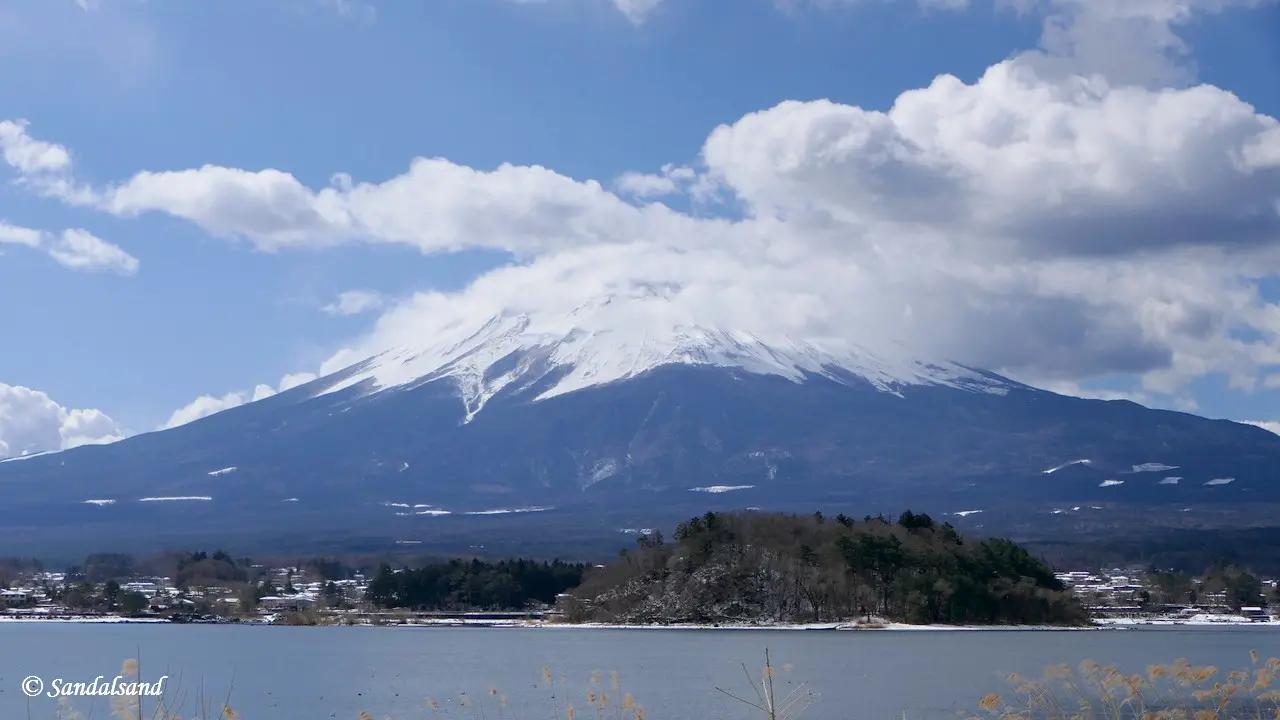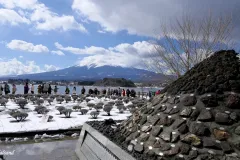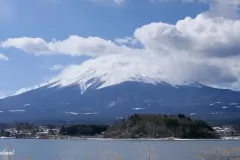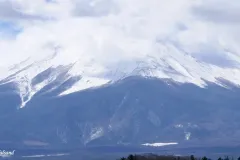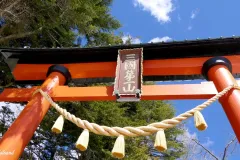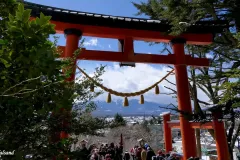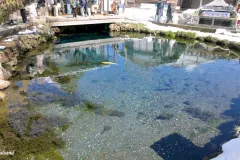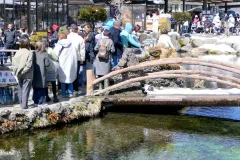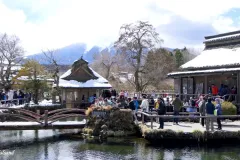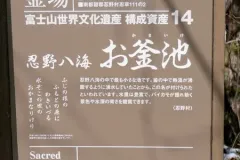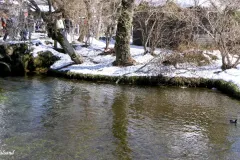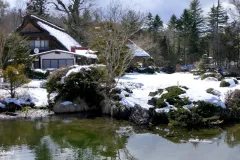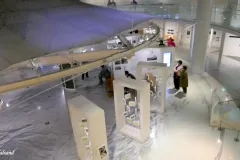Fujisan has for decades been the most famous icon of Japan, all over the world. For the Japanese the perfectly cone-shaped volcano has drawn attention and worshippers for a thousand years and more.
The UNESCO World Heritage List includes over a thousand properties. They have outstanding universal value and are all part of the world’s cultural and natural heritage.
Official facts
- Official title: Fujisan, sacred place and source of artistic inspiration
- Country: Japan
- Date of Inscription: 2013
- Category: Cultural
UNESCO’s World Heritage Centre’s short description of site no. 1418:
The beauty of the solitary, often snow-capped, stratovolcano, known around the world as Mount Fuji, rising above villages and tree-fringed sea and lakes has long been the object of pilgrimages and inspired artists and poets. The inscribed property consists of 25 sites which reflect the essence of Fujisan’s sacred and artistic landscape. In the 12th century, Fujisan became the centre of training for ascetic Buddhism, which included Shinto elements.
On the upper 1,500-metre tier of the 3,776m mountain, pilgrim routes and crater shrines have been inscribed alongside sites around the base of the mountain including Sengen-jinja shrines, Oshi lodging houses, and natural volcanic features such as lava tree moulds, lakes, springs and waterfalls, which are revered as sacred. Its representation in Japanese art goes back to the 11th century, but 19th century woodblock prints of views, including those from sand beaches with pine tree groves have made Fujisan an internationally recognized icon of Japan and have had a deep impact on the development of Western art.
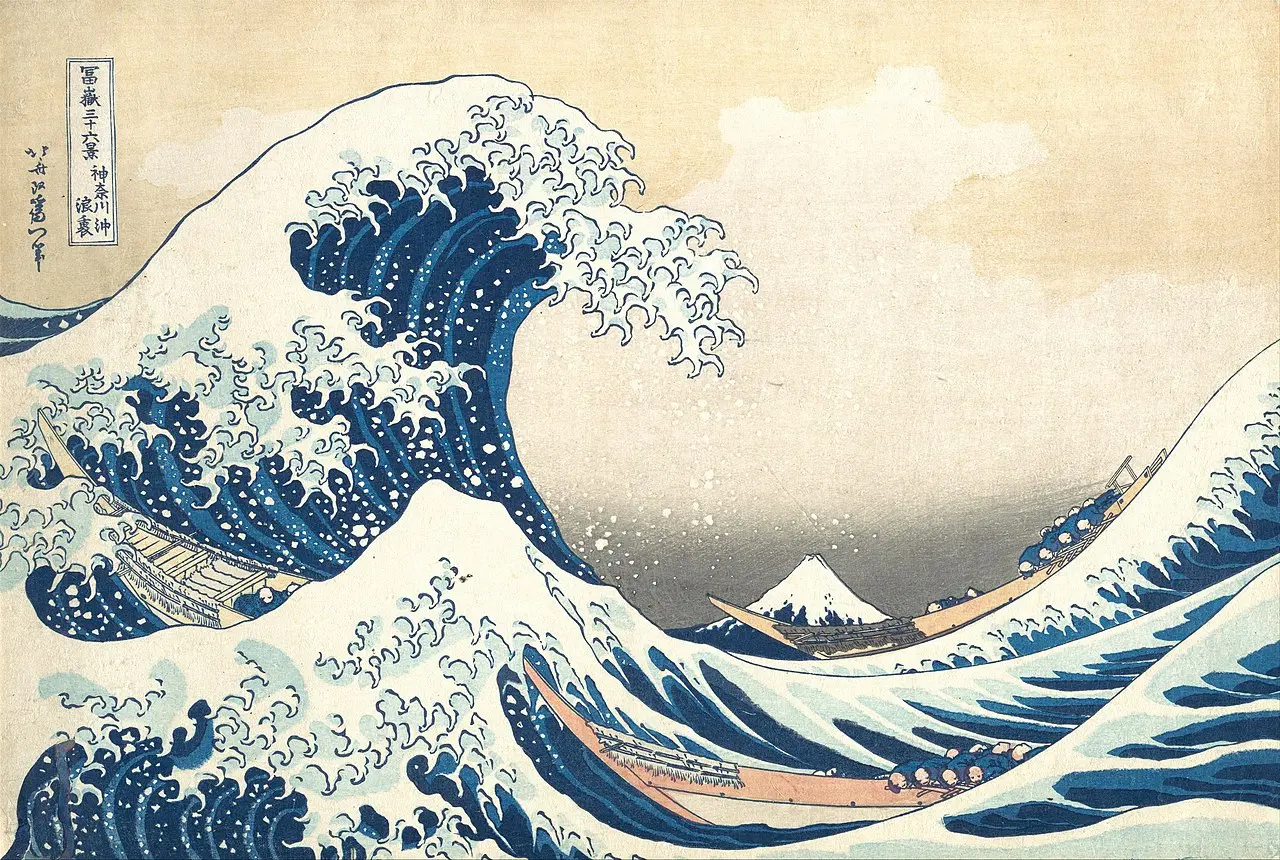
There is more to know about Fujisan
Mount Fuji is Fujisan in Japanese. It is Japan’s highest and most iconic peak, and has held profound cultural, spiritual, and artistic significance for centuries. Rising to 3,776 meters, the nearly symmetrical cone has long been revered as a sacred mountain. In ancient Shinto beliefs, it was seen as the dwelling place of deities, while Buddhist traditions associated it with enlightenment and spiritual rebirth. Pilgrimages to its summit began during the Heian period (794–1185) and became more widespread in the Edo period (1603–1868), when organized climbing routes were established by religious sects such as the Fuji-kō.
Fuji’s influence extends deeply into Japanese art and literature. It is immortalized in classical poetry and famously depicted in ukiyo-e prints by artists like Katsushika Hokusai and Utagawa Hiroshige. These visual works, especially Hokusai’s Thirty-Six Views of Mount Fuji, helped cement the mountain as a symbol of national identity. (The best known of the 36 is the one above.)
Beyond its religious and artistic roles, Mount Fuji serves as a powerful emblem of endurance, beauty, and unity. Even today, it inspires millions of climbers and continues to appear in contemporary media and design. Recognized as a UNESCO World Heritage Site in 2013 for its cultural importance, Mount Fuji remains a living symbol of Japan’s spiritual and artistic heritage.
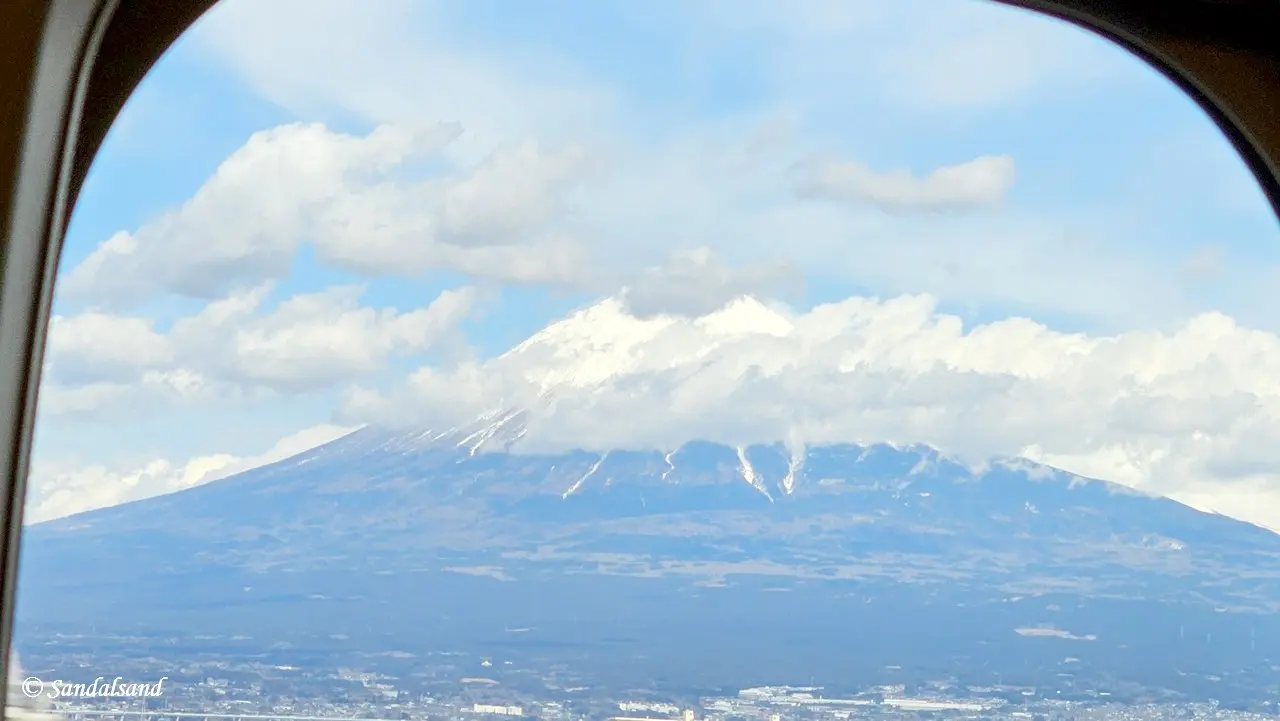
What to discover around Fujisan?
Even today pilgrims flock to ascend the summit for spiritual reasons. Thousands more come for more mundane objectives – the mountain is one of the most visited tourist sights in Japan. Just to emphasise, that goes for Japanese tourists as well. On our visit, slightly off the peak season, the majority of people around us were from Japan.
We went on a full-day guided excursion trip from Tokyo in March 2025. There are many alternative trip providers, so have a good look at Get-Your-Guide, for instance. Some prefer to stay the night in the region, perhaps in a ryokan (traditional hot baths) with a view of the mountain.
There are many alternatives, depending on your interests and how thick your wallet is. Also, it depends on the season. We arrived on the day after a quite heavy snowfall, so all possible stops on the slopes were inaccessible. Instead we stopped at four places at the base, and I will just give a brief introduction to each.
Lake Kawaguchi – Oishi Park
Our first stop was at Oishi Park. It offers one of the most iconic views of Mount Fuji, with seasonal flower displays framing the mountain across Lake Kawaguchi. This lake is one of several around the mountain. Popular in spring and autumn, the park’s walking paths and observation decks make it a favourite photo spot, blending natural beauty with peaceful lakeside charm.
Shimoyoshida Station and Arakurayama Sengen Park
The next stop was at Shimoyoshida Station. It has rail links with the surrounding world and is a convenient stop for those who want to visit the Fujisan by themselves. Coaches let their passengers off here and ask them to walk the few hundred metres to the Arakurayama Sengen Park. This park is home to the famous five-storied Chureito Pagoda. A steep climb rewards visitors with a panoramic vista: Mount Fuji rising behind the pagoda, especially stunning during cherry blossom season.
We came here just before that season. People who did not fancy to walk all those steps, especially in wet snow, got a good view also after a short hike.
Oshino Village
Oshino Hakkai, a set of eight crystal-clear ponds in Oshino Village, is fed by snow-melt from Mount Fuji. Traditional thatched-roof houses, scenic watermills, and views of Fuji create a charming setting. The village preserves a sense of old Japan and draws visitors seeking nature, tranquillity, and cultural authenticity.
Well, finding tranquillity might be a bit exaggerated during daytime, but it would be a good place to stay the night. Even in the off-peak season the small, but extremely charming village was crammed with people wandering about between the ponds.
Fujisan World Heritage Center
Located in Fujinomiya, the Fujisan World Heritage Center explores Mount Fuji’s cultural and spiritual legacy. The modern, eco-conscious building houses exhibitions on the mountain’s geology, history, and religious significance. An impressive cone-shaped design mirrors Fuji itself, making the centre both an educational and architecturally symbolic experience.
This was a very interesting stop, but the case with Mount Fuji is that a museum will never quite be the same as actually seeing the mountain with your own eyes. In addition, a stop here at the start would perhaps have given a better understanding of the significance of the other places we stopped at. On the other hand UNESCO writes that the inscribed property consists of 25 sites, so there are plenty to choose from.
Conclusion
You should not miss a visit to Mount Fuji, or Fujisan, when you are in Japan. That is what I did my first time in the country, 40 years ago, save for a distant glimpse from a passing vehicle. Therefore I was very content with my priorities this time around. The only thing I really missed, was to actually drive to some of the stations up on the mountain slopes for a view of the surrounding countryside. The scenery is great.
One more thing: I would have loved to see that summit on a clear day. So perhaps next time, in Japan.
Read more
Find more articles from Japan on Sandalsand.
Browse to the PREVIOUS or NEXT post in this series.
Extra: All 25 component parts
While many associate the site simply with the mountain itself, the inscription actually includes 25 component parts: the volcanic mountain plus 24 related cultural locations. Here is a list of the 25 sites, grouped and briefly commented. UNESCO itself organises these as religious sites, routes, natural features, and artistic viewpoints.
1. The Sacred Mountain
- Mount Fuji – Japan’s highest peak (3,776 m), revered as sacred and a symbol of beauty. Its near-perfect cone has inspired art, religion, and national identity.
2. Shrines of Mount Fuji Worship
- Fujisan Hongū Sengen Taisha – Main Shrine Grounds – Head shrine of the Sengen network, dedicated to the mountain deity. A key site for pilgrims.
- Fujisan Hongū Sengen Taisha – Inner Shrine at the Summit – A shrine located at the mountain’s peak, representing the spiritual goal of Fuji pilgrimage.
- Yamamiya Sengen-jinja Shrine – An ancient shrine without a main hall, designed for direct worship of Mount Fuji as a sacred body itself.
- Murayama Sengen-jinja Shrine – Former center of Fuji religious practices and home to ascetic monks. Reflects Mount Fuji’s role in Shugendō.
- Suyama Sengen-jinja Shrine – Base for southern pilgrims and one of the oldest Fuji-related shrines, preserving traditions of worship and prayer.
- Fuji Sengen-jinja Shrine (Fujiyoshida) – Northern gateway to the Yoshida Trail. Still active as a starting point for modern climbers and pilgrims.
- Osano Sengen-jinja Shrine – Smaller site with deep local ties, highlighting the spread of Fuji worship throughout nearby communities.
- Kawaguchi Asama-jinja Shrine – Famous for ancient cedar trees and as a place of worship for pilgrims arriving via Lake Kawaguchi.
- Fuji Omuro Sengen-jinja Shrine – Among the earliest Fuji shrines, offering evidence of early mountain worship traditions.
- Shimo-Gongendō and Kami-Gongendō – Paired worship halls used by ascetic practitioners, reflecting Edo-period religious architecture.
3. Pilgrimage and Worship Culture
- Funatsu Yama-no-Kami Shrine and Fuji-kō Houses – Preserved village houses used by Fuji-kō followers, alongside a shrine to the mountain gods.
- Oshi Houses in Yoshida – Traditional lodging for pilgrims, run by Fuji priests (oshi), who offered spiritual guidance and ritual preparation.
4. Historic Pilgrimage Routes
- Yoshida Trail Historic Remains – Main Edo-period climbing route with stone markers and rest stops, still in use today by many climbers.
- Subashiri Trail Historic Remains – Eastern pilgrimage route with historic pathways and sites for prayer and reflection.
- Suyama Trail Historic Remains – Southern approach up Fuji with remnants of ancient stairways and religious sites.
- Murayama Trail Historic Remains – The oldest known trail, used by early mountain monks and Fuji ascetics.
- Hitoana Fuji-kō Iseki – Sacred cave associated with Kakugyō, the founder of Fuji-kō. Important spiritual retreat and pilgrimage site.
5. Fuji’s Lakes and Natural Scenery
- Lake Kawaguchi – One of the Fuji Five Lakes, celebrated for scenic beauty and artistic inspiration. A favorite viewing spot for the mountain.
- Lake Yamanaka – The largest of the Five Lakes, long associated with pilgrimage rest and stunning reflections of Fuji.
- Lake Sai – A quieter lake linked to mystical traditions and spiritual reflection. Offers unique views of Fuji’s slopes.
- Lake Shōji – The smallest lake, known for its calm waters and intimate views of Mount Fuji’s peak.
- Lake Motosu – Depicted on the 1,000-yen note, known for deep, clear waters and striking views of Fuji’s western side.
- Shiraito Falls – Sacred waterfall used for ritual purification by pilgrims. Resembles flowing white threads cascading over rock.
6. Artistic and Poetic Inspiration
- Miho-no-Matsubara – Coastal pine grove offering scenic, distant views of Mount Fuji over the sea. Celebrated in poetry and ukiyo-e prints.

